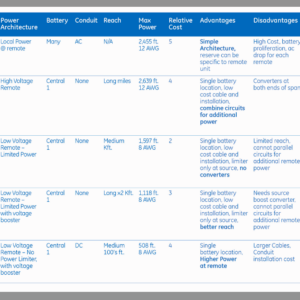As today’s sports and music fans post data-hungry tweets, selfies and text messages from live events, stadium and large venue facility managers are struggling to manage wireless data capacity to keep their systems up and running during peak times. During the 2015 Super Bowl, for example, fans in and around the stadium used more than 6.8 terabytes of mobile data on the four leading carrier networks.
Wireless engineers and designers, facing the limits of traditional macro cell towers and Wi-Fi at these venues, are adopting a host of small cell and distributed antenna systems solutions. These systems rely on a network of smaller communications nodes across a defined area to fill in the gaps in wireless coverage and to add additional capacity to existing high-user high-traffic areas.
Both small cell systems, including picocells, metrocells and microcells, and DAS offer advantages and disadvantages depending on a number of factors. The choice of technology depends on the setting, existing wire and cabling infrastructure, service provider needs and power availability.
When it comes to choosing small cell and DAS solutions, part of the evaluation is the power and requisite power back-up requirements for these various options. Most small cell options, for example, generally rely on individual AC power supplies near each communications node. In this scenario, power protection is provided by either AC or DC uninterruptible power supply units at each location. While this approach requires higher power equipment and installation costs for the combined locations and ongoing maintenance and battery back-up replacement costs, these considerations need to be weighed against lower up-front costs, reduced infrastructure requirements and faster deployment.
Further, in large venue or stadium settings, most small cell public-site deployments are designed to handle anywhere from 20 to 30 users (for picocells and metrocells) up to 200 users (in a microcell application) and have coverage areas of tens to hundreds of feet. Given the need to manage cell traffic for thousands of fans in a stadium or entertainment venue, a DAS system, which can handle as many as 1,800 users per system, is the preferred method. Distributed antenna systems have larger coverage areas, on the order of thousands of feet, and as the name implies, rely on more centralized approaches to power supply and power protection scenarios.
A set of power solutions
In evaluating the power supply and protection requirements for a large venue, a number of factors can be looked at, from whether there is local vs. centralized power, to the power requirements for various high- or low-voltage circuits.
Local power
As stated earlier, to power a small radio set with uninterruptible power requires a battery backup to power the network during utility interruptions. The remote radio heads typically used by DAS or small cell architectures can be powered with AC 110/240 volts, or DC -48 volts. Local power requires the availability and provisioning of an AC outlet and the installation of a suitable AC or DC UPS.
Without the complicated power supply and distribution architecture, local power solutions provide easy deployments, assuming local power feeds are already in place. However, the cost of installing a UPS and battery maintenance for each local wireless or radio node also needs to be factored into the power design specification.
Remote power/central UPS
Provisioning of a larger UPS, either AC or DC, to power many remote radios from a central location offers many advantages, including reduced maintenance and replacement costs associated with multiple battery locations.
Power-limited high-voltage DC circuit: A power-delivery infrastructure using high-voltage DC (+/-190 volts) with a 100-watt power limit per circuit can be installed using an appropriate cable, without the installation costs of a protective conduit. As most remote radios do not accept +/-190 volts of DC directly, a down converter is used. The use of high-voltage power over smaller cables increases the overall power reach.
To achieve a load power greater than 100 W, multiple power-limited circuits also can be combined. In this case, each circuit can use heavier gauge wire or multiple conductors to achieve a greater reach.
Power-limited low-voltage circuit: A power-delivery infrastructure using low-voltage DC.
The use of a power combiner can be used to bundle NEC Class 2 circuits to provide adequate power and NEC-compliant power.
Larger load requirements and non-power-limited low voltage circuits: Several DAS system manufacturers are using remote radios that require more than 100 W of power. These cannot be used with Class 2 circuits because of the power limitation.
If the power limiter is removed, a low voltage circuit can be used to power larger loads or to span longer distances. However, the NEC standard now mandates that the circuit must be protected by running it in a conduit. This additional conduit increases installation costs, but may be the only option to power larger loads if a multicircuit high-voltage approach is not practical.
Paul Smith, technical marketing manager at GE’s Critical Power business, works with data center and communications customers to build and sustain massive data and wireless network capacity with reliable and energy-efficient power. To learn more about GE’s Critical Power business, visit gecriticalpower.com.
Editor’s Note: In an attempt to broaden our interaction with our readers we have created this Reader Forum for those with something meaningful to say to the wireless industry. We want to keep this as open as possible, but we maintain some editorial control to keep it free of commercials or attacks. Please send along submissions for this section to our editors at: dmeyer@rcrwireless.com.

